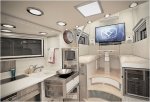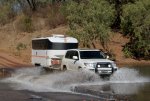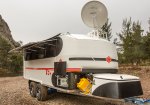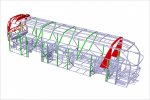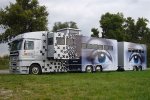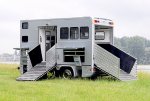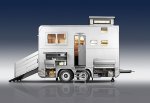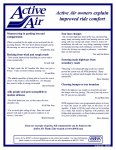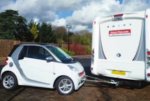biotect
Designer
,,
CONTINUED FROM PREVIOUS POST
*********************************************
7. Electric versus Hydro-Drive Hub Motors?
*********************************************
Moving along in your post: very interesting contrast between electric motors and hydro-drive hub motors. I have to confess that I don't know that much about hydro-drive motors, and will need to research these further. So many thanks for this heads-up. The costs/benefits of each type of motor are very much worth discussing further in this thread. Same with all of your thoughts about battery size, focusing on energy recovery through regenerative braking, additional solar panel coverage when the vehicle is stopped via expansive awnings, and so on. Lots of interesting stuff worth discussing further, at great length.
Here are some preliminary follow-through links for the names that you gave for hydraulic motors, along with some videos: http://www.truck.man.eu/global/en/f...technology/man-hydrodrive/MAN-HydroDrive.html , http://www.truck.man.eu/man/media/e...ess_website_truck_master_1/MAN_HydroDrive.pdf , http://www.garage-barras.ch/Image/man_hydrodrive_.pdf , http://www.poclain-hydraulics.com/en , http://www.poclain-hydraulics.com/en/systems/trucks , http://www.poclain-hydraulics.com/en/systems/trucks/enhanced-mobility-trailer-wheel-assistance-ref27 , http://en.wikipedia.org/wiki/Hydraulic_drive_system , and http://en.wikipedia.org/wiki/Hydraulic_motor :
[video=youtube;Vib4f79v4kQ]http://www.youtube.com/watch?v=Vib4f79v4kQ [/video]
[video=youtube;5eu5QhBZFJo]http://www.youtube.com/watch?v=5eu5QhBZFJo&index=7&list=PLfp_nxCjWatfxyRC CKsct4-eUa1eCBUp_[/video]
Also see the YouTube playlists about Hydro-drives in general (not just the MAN product), at http://www.youtube.com/playlist?list=PLfp_nxCjWatfxyRCCKsct4-eUa1eCBUp_ and http://www.youtube.com/playlist?list=PLq5iMr_Q7XgufhzgOwQnzq2rnpBenTHbA .
In the MAN schematic, it looks like the pump for the hydraulic motor is directly driven by the main diesel engine:
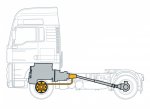
So you seem to be arguing for a fairly conventional drive train, in which a diesel engine drives one axle for highway driving, and the vehicle still has a large transmission. But hydraulic motors kick in to provide added torque and all-wheel drive for off-road or bad-road travel. Is this your position? If I am mistaken, please correct me.
This idea generates some questions. First, which axle should the diesel engine drive in the course of normal highway travel? Presumably the rear, as per this MAN schematic? Second, as such, the vehicle would still need a rear differential. But are other options possible? The hydraulic motors seem to mount individually as hub motors. So in theory at least, they could mount on the rear wheels, with the diesel only directly driving the front wheels? However, although any number of cars exist that are front-wheel drive, very few trucks are -- see http://en.wikipedia.org/wiki/Front-wheel_drive and http://en.wikipedia.org/wiki/Automobile_layout#Rear-wheel-drive_layouts .
If you have any blueprints, schematics, or images of what a typical 4x4 and/or 6x6 set-up would look like, with hydro-drive motors installed instead of all-wheel drive, please post!!
Next, I get the impression that you are generally disposed against a serial hybrid solution and electric motors. It would be great if you might be willing to provide an itemized list as to why.
One of the main reasons I am in favor of a serial hybrid solution, in the case of an expedition motorhome in particular, is because the motorhome must already have a massive battery bank. And so too maximal solar, as well as a diesel generator. Like egn, I disagree with Earthroamer's position that a supplementary diesel generator is unnecessary. Yes, even if one does have maximal solar and high-output dual alternators.
So it seems that a natural "next step" would be to combine the supplementary diesel generator with the main diesel engine, as a single large 120 KW generator (as per the Jepotnik), producing power that drives electric hub motors. Ergo, a serial hybrid. Furthermore, electric motors are a kind of natural application for regenerative braking, because when put into reverse, they function like alternators and generate electricity -- see http://auto.howstuffworks.com/auto-parts/brakes/brake-types/regenerative-braking1.htm . Of course as the short web-page just referenced suggests, in actual practice it's more complicated than that. But that's the general idea. And so too, electric motors might eliminate any need for a low-hanging differential, as one participant suggested earlier in the thread (I can't remember who....?). And finally, electrical motors build in redundancy, especially if there are two or more of them. Perhaps one driving each axle (in a 4x4 or 6x6 arrangement), as recommended by egn and Haf-E. Or perhaps one driving each wheel, thereby eliminating any need for a low-hanging differential? As suggested further along, design for redundancy seems the future, not design for self-repairability.
I am still trying to get up to speed as regards all the more "exotic" power train possibilities. But it would be very interesting to hear more from you about these questions in particular (as opposed issues like window size, curvilinear aesthetics, or motorhome height.... i.e. issues where we will have to agree to disagree. ) And it would be interesting to know why you want to advocate a much more conventional sort of solution, in which the diesel engine still directly drives an axle, and is otherwise supplemented only by hydraulic hub motors.
) And it would be interesting to know why you want to advocate a much more conventional sort of solution, in which the diesel engine still directly drives an axle, and is otherwise supplemented only by hydraulic hub motors.
By the way, "Renault optidrive" proved less promising as a reference, and only produced webpages for some of Renault's bigger trucks. Do you have a good link for Renault? And any weblinks for possible Mercedes and Volvo hydraulic motor solutions?
*********************************************
8. Multi-Fuel? ICE versus Microturbine?
*********************************************
Fully agreed that I will want the vehicle configured for "MAX DIESEL": a 1500 liter tank, if possible. And I can really see your point about the efficiency problems that multi-fuel capability generates, as well as your excellent and well-argued points about the power-cut-off point where diesels become more efficient than turbines.
As for engine weight, given the existence of the Jepotnik gen-set that produces 120 KW, and that weighs just 350 kg, I find myself swinging strongly in the direction of a rod-and-piston diesel generator solution, and not a microturbine generator solution.
*********************************************
9. Top Speed?
*********************************************
It's very interesting that you say "forget the 140 kmh". This maximum speed was campo's proposal, so I just repeated it. Mañana, for instance, only has a top speed of 110 kmh.
campo: if you are reading this, why did you propose 140 kmh?
And egn, likewise, if you are reading this, do you think 140 kmh is at all necessary for a large motorhome? Should 120 kmh suffice, as suggested by thjakits?
*********************************************
10. Windows and Walls
*********************************************
As for window sizes, here seems another place where we will simply have to agree to disagree. I know how you feel about large windows, and I understand your position. But I still disagree with you. The Kimberley T3 Caravan is an off-road camper, and yet it has enormous windows. See below. Mañana also has large windows, as large as those found in more regular, mainstream motorhomes. And yet Mañana traveled all over Australia, and down most of Australia's more famous dirt tracks, with the major exception of the Canning Stock Route.
So probably best to give windows a rest, don't you think?
It's worth remembering that this project is supposed to be innovative, not merely based on "technology available right now, and previously used in a motorhome application". So although I still have to do the research, I see no reason why large triple-pane windows could not be specified, for all windows except the front windshield. Furthermore, as I have already indicated, I need to contact Bürstner to find out the R-value for the windshield on their new "Panorama" motorhome.
campo is the thermal engineering expert, and he seems to see no problem, in principle, with large windows -- at least from a thermal perspective. I will be gradually working out the thermal consequences of large windows and skylights in concert with campo, over in the "Camper Thermal Engineering Thread". But needless to say, I will be inclined to go with the biggest windows I can get away with reasonably, from a thermal perspective.
Sorry about the typo regarding wall thickness: clearly I meant 6 cm, instead of 6 m. I've gone back and corrected it. Many thanks for noticing this typo!
*********************************************
11. Absolutely not Air-Transportable
*********************************************
Interesting that you claim that almost anything is air-transporatable, as long at it is 20 tons.
But again, for me personally, air-tranportabiliy has never been a consideration. Air-transportabiilty is absolutely not a design objective for me. I have no interest whatsoever in air-tranportability.
I cannot be any more clear than that......
*********************************************
12. Slide-Outs and Pop-Ups. Swing-Outs?
*********************************************
Here you remarked that properly designed slide-outs can be very reliable, and not that heavy. Care to elaborate? I actually do have some slide-outs in mind, but would first like to hear what you have to say about how these might be best designed for an expedition motorhome. For instance, would you go with hydraulic slide-outs, or electric winch-driven slide-outs?
And what do you think about the "swing outs" on the Maxi-Mog trailer and the Kiravan?






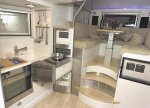
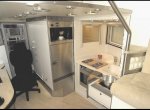
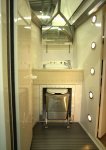
*********************************************
CONTINUED IN NEXT POST
.
CONTINUED FROM PREVIOUS POST
*********************************************
7. Electric versus Hydro-Drive Hub Motors?
*********************************************
Also already posted - google up on MAN-hydro drive, RENAULT-optidrive, POCLAIN hydro-drive [the inventor and patent holder of this], MERCEDES is catching up too and VOLVO has something coming too [being the de-facto step-mother of Renault these days....] for every driven conventional axle replaced by non-driven axle with hydro-drive hubs you save roughly 400kg - maybe not for EVERY axle, I don't know if this number already includes the transfercase/drive.
You still can use the AWD-drive without a time limit, but when it is off you save weight/energy.
Moving along in your post: very interesting contrast between electric motors and hydro-drive hub motors. I have to confess that I don't know that much about hydro-drive motors, and will need to research these further. So many thanks for this heads-up. The costs/benefits of each type of motor are very much worth discussing further in this thread. Same with all of your thoughts about battery size, focusing on energy recovery through regenerative braking, additional solar panel coverage when the vehicle is stopped via expansive awnings, and so on. Lots of interesting stuff worth discussing further, at great length.
Here are some preliminary follow-through links for the names that you gave for hydraulic motors, along with some videos: http://www.truck.man.eu/global/en/f...technology/man-hydrodrive/MAN-HydroDrive.html , http://www.truck.man.eu/man/media/e...ess_website_truck_master_1/MAN_HydroDrive.pdf , http://www.garage-barras.ch/Image/man_hydrodrive_.pdf , http://www.poclain-hydraulics.com/en , http://www.poclain-hydraulics.com/en/systems/trucks , http://www.poclain-hydraulics.com/en/systems/trucks/enhanced-mobility-trailer-wheel-assistance-ref27 , http://en.wikipedia.org/wiki/Hydraulic_drive_system , and http://en.wikipedia.org/wiki/Hydraulic_motor :
[video=youtube;Vib4f79v4kQ]http://www.youtube.com/watch?v=Vib4f79v4kQ [/video]
[video=youtube;5eu5QhBZFJo]http://www.youtube.com/watch?v=5eu5QhBZFJo&index=7&list=PLfp_nxCjWatfxyRC CKsct4-eUa1eCBUp_[/video]
Also see the YouTube playlists about Hydro-drives in general (not just the MAN product), at http://www.youtube.com/playlist?list=PLfp_nxCjWatfxyRCCKsct4-eUa1eCBUp_ and http://www.youtube.com/playlist?list=PLq5iMr_Q7XgufhzgOwQnzq2rnpBenTHbA .
In the MAN schematic, it looks like the pump for the hydraulic motor is directly driven by the main diesel engine:

So you seem to be arguing for a fairly conventional drive train, in which a diesel engine drives one axle for highway driving, and the vehicle still has a large transmission. But hydraulic motors kick in to provide added torque and all-wheel drive for off-road or bad-road travel. Is this your position? If I am mistaken, please correct me.
This idea generates some questions. First, which axle should the diesel engine drive in the course of normal highway travel? Presumably the rear, as per this MAN schematic? Second, as such, the vehicle would still need a rear differential. But are other options possible? The hydraulic motors seem to mount individually as hub motors. So in theory at least, they could mount on the rear wheels, with the diesel only directly driving the front wheels? However, although any number of cars exist that are front-wheel drive, very few trucks are -- see http://en.wikipedia.org/wiki/Front-wheel_drive and http://en.wikipedia.org/wiki/Automobile_layout#Rear-wheel-drive_layouts .
If you have any blueprints, schematics, or images of what a typical 4x4 and/or 6x6 set-up would look like, with hydro-drive motors installed instead of all-wheel drive, please post!!
Next, I get the impression that you are generally disposed against a serial hybrid solution and electric motors. It would be great if you might be willing to provide an itemized list as to why.
One of the main reasons I am in favor of a serial hybrid solution, in the case of an expedition motorhome in particular, is because the motorhome must already have a massive battery bank. And so too maximal solar, as well as a diesel generator. Like egn, I disagree with Earthroamer's position that a supplementary diesel generator is unnecessary. Yes, even if one does have maximal solar and high-output dual alternators.
So it seems that a natural "next step" would be to combine the supplementary diesel generator with the main diesel engine, as a single large 120 KW generator (as per the Jepotnik), producing power that drives electric hub motors. Ergo, a serial hybrid. Furthermore, electric motors are a kind of natural application for regenerative braking, because when put into reverse, they function like alternators and generate electricity -- see http://auto.howstuffworks.com/auto-parts/brakes/brake-types/regenerative-braking1.htm . Of course as the short web-page just referenced suggests, in actual practice it's more complicated than that. But that's the general idea. And so too, electric motors might eliminate any need for a low-hanging differential, as one participant suggested earlier in the thread (I can't remember who....?). And finally, electrical motors build in redundancy, especially if there are two or more of them. Perhaps one driving each axle (in a 4x4 or 6x6 arrangement), as recommended by egn and Haf-E. Or perhaps one driving each wheel, thereby eliminating any need for a low-hanging differential? As suggested further along, design for redundancy seems the future, not design for self-repairability.
I am still trying to get up to speed as regards all the more "exotic" power train possibilities. But it would be very interesting to hear more from you about these questions in particular (as opposed issues like window size, curvilinear aesthetics, or motorhome height.... i.e. issues where we will have to agree to disagree.
By the way, "Renault optidrive" proved less promising as a reference, and only produced webpages for some of Renault's bigger trucks. Do you have a good link for Renault? And any weblinks for possible Mercedes and Volvo hydraulic motor solutions?
*********************************************
8. Multi-Fuel? ICE versus Microturbine?
*********************************************
You will have to balance the battery size, between storage capacity for at least 18 hrs to operate the camped vehicle and charging technology so that you can take advantage of the most efficient output range of the diesel generator. Optimize for MAX DIESEL storage capacity (no matter if you use a diesel engine or turbine, a ROAD-destined turbine will hardly ever be Jet-fuel powered....).
..................
Multifuel-capability? FORGET IT! I don't know of ANY Multifuel-motor out there that keeps its efficiency compared to any dedicated-fuel engine.
Whatever you think you might gain by being able to buy cheaper alternate fuels you WILL loose on efficiency, complexity and reliability elsewhere!
Fully agreed that I will want the vehicle configured for "MAX DIESEL": a 1500 liter tank, if possible. And I can really see your point about the efficiency problems that multi-fuel capability generates, as well as your excellent and well-argued points about the power-cut-off point where diesels become more efficient than turbines.
As for engine weight, given the existence of the Jepotnik gen-set that produces 120 KW, and that weighs just 350 kg, I find myself swinging strongly in the direction of a rod-and-piston diesel generator solution, and not a microturbine generator solution.
*********************************************
9. Top Speed?
*********************************************
Bio! If you are out travelling - you will HARDLY EVER want to go 140 - especially with a BIG RIG! I did 130km/h once with a 18m tractor trailer in old East Germany (don't tell anyone!) with brand-new Scania 143 - 400hp - just short of red line rpm - fantastic, I think this was 1989!! But this was a HIGHWAY-rig!!
I wonder what the average Touring/Travel speed of the Big-Rig-Owners here is?
I suppose if you plan for a max of 120 it will be hardly ever used - going electric of course has a lot of flexibility here.
Using the above mentioned Tires - I doubt these will like your speed proposal either!
Look up what a common tire/wheel-size is for the purpose - considering you WANT some serious ground clearance - probably some R22.5 - I assume....
Considering, that you already specify "additional mobility" - I suggest to stick to common and efficient tires, like High-Grip Road tires (Gravel pit trucks, etc...) though I would go for the tallest ones available.
Save the Michelin-Super-X for the trailered "additional mobility"!
.........
What I say - forget the 140km/h!!!
It's very interesting that you say "forget the 140 kmh". This maximum speed was campo's proposal, so I just repeated it. Mañana, for instance, only has a top speed of 110 kmh.
campo: if you are reading this, why did you propose 140 kmh?
And egn, likewise, if you are reading this, do you think 140 kmh is at all necessary for a large motorhome? Should 120 kmh suffice, as suggested by thjakits?
*********************************************
10. Windows and Walls
*********************************************
You want to re-think those very big windows - see previous post!
.....and those 6m thick walls!! You probably meant 6 cm???
As for window sizes, here seems another place where we will simply have to agree to disagree. I know how you feel about large windows, and I understand your position. But I still disagree with you. The Kimberley T3 Caravan is an off-road camper, and yet it has enormous windows. See below. Mañana also has large windows, as large as those found in more regular, mainstream motorhomes. And yet Mañana traveled all over Australia, and down most of Australia's more famous dirt tracks, with the major exception of the Canning Stock Route.
So probably best to give windows a rest, don't you think?
It's worth remembering that this project is supposed to be innovative, not merely based on "technology available right now, and previously used in a motorhome application". So although I still have to do the research, I see no reason why large triple-pane windows could not be specified, for all windows except the front windshield. Furthermore, as I have already indicated, I need to contact Bürstner to find out the R-value for the windshield on their new "Panorama" motorhome.
campo is the thermal engineering expert, and he seems to see no problem, in principle, with large windows -- at least from a thermal perspective. I will be gradually working out the thermal consequences of large windows and skylights in concert with campo, over in the "Camper Thermal Engineering Thread". But needless to say, I will be inclined to go with the biggest windows I can get away with reasonably, from a thermal perspective.
Sorry about the typo regarding wall thickness: clearly I meant 6 cm, instead of 6 m. I've gone back and corrected it. Many thanks for noticing this typo!
*********************************************
11. Absolutely not Air-Transportable
*********************************************
Mate!! NO worries - if you really want [air-transportability] - I have the connections to get you air-transport for anything you can fit on a road (2.5 m wide and less than a 100 tons total)!! If you want to get brought in on the spot you can go bigger but need to stay below 20 tons.
Question is if you have the dough to pay the service and will survive seeing the invoice!
Interesting that you claim that almost anything is air-transporatable, as long at it is 20 tons.
But again, for me personally, air-tranportabiliy has never been a consideration. Air-transportabiilty is absolutely not a design objective for me. I have no interest whatsoever in air-tranportability.
I cannot be any more clear than that......
*********************************************
12. Slide-Outs and Pop-Ups. Swing-Outs?
*********************************************
Pop-up will probably not help with the weight - but I do agree this is a great idea to make it roomy for longer stays.
But then get on it and do slide-outs too - properly designed they ARE reliable and not that heavy.
Here you remarked that properly designed slide-outs can be very reliable, and not that heavy. Care to elaborate? I actually do have some slide-outs in mind, but would first like to hear what you have to say about how these might be best designed for an expedition motorhome. For instance, would you go with hydraulic slide-outs, or electric winch-driven slide-outs?
And what do you think about the "swing outs" on the Maxi-Mog trailer and the Kiravan?









*********************************************
CONTINUED IN NEXT POST
.
Last edited:





